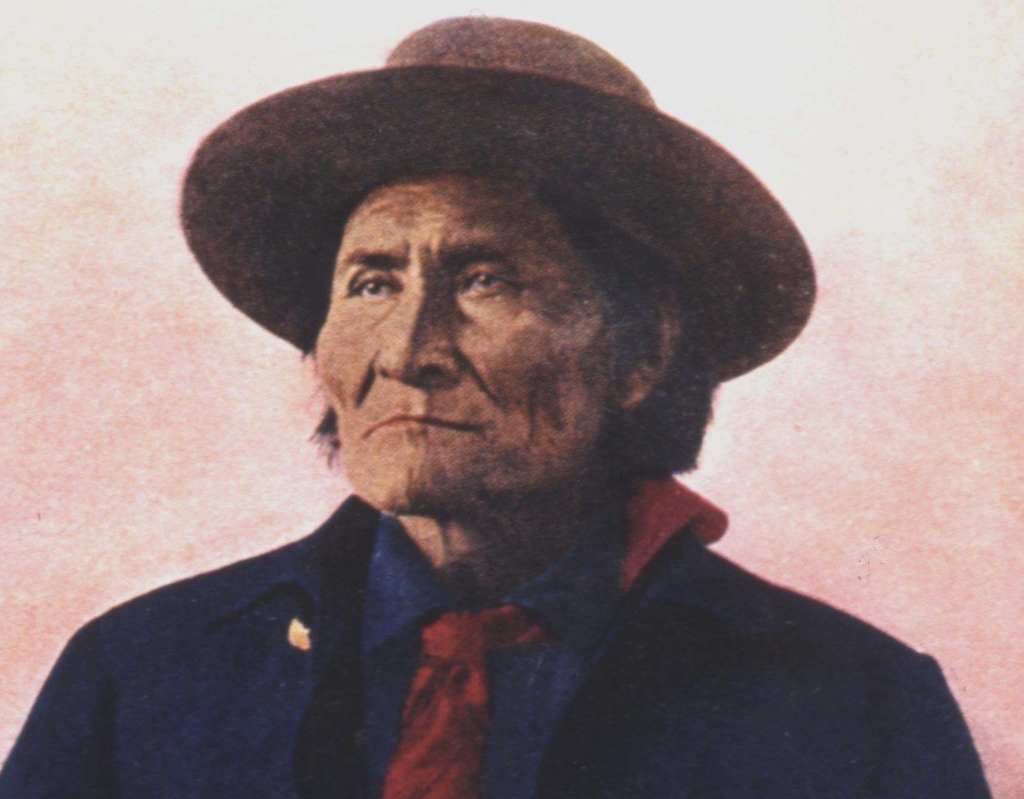GeronimoBy Dallas & Constance SalasOctober 15, 2019
Geronimo
By Dallas & Constance Salas
October 15, 2019
Timeline 1829-1909
Timeline 1829-1909
Geronimo was a fearless Native American guerilla warrior. He was a chivalrous hero that fought for freedom, justice, and equality. He led his tribe against white settlers in Arizona for more than thirty years.
“I cannot think that we are useless or God would not have created us. There is one God looking down on us all. We are all the children of one God. The sun, the darkness, the winds are all listening to what we have to say.”
~ Geronimo
Timeline
Timeline
June 1829: Born in Nodoyohn Canyon, Arizona. Out of four boys and four girls of that family only himself, his brother (Poric freedoo), and his sister (Nuh-da-ste) were yet alive.
1846: When he was seventeen, he was admitted to the Council of the Warriors, which allowed him to go wherever he wanted and do whatever he wanted. He was going to marry. Soon, he received permission from the council and Chief of the Chiricahua Apaches; then he married a woman named Alope (Daughter of Chief of the Chiricahua Apaches), and the couple had three children.
1851: His tribe went to trade in Mexico during a peaceful time. Then, while they went to go into the city Kas-Ki-Yeh his aged mother, young wife, and three children were killed along with the others who were massacred by the Mexican Soldiers led by Colonel Jose Maria Carrasco who ambushed his Bedonkohe encampment. Geronimo stood by the river in silence, all of the bodies that were at Kas-Ki-Yeh stayed there and they had to retreat. vowed to seek revenge for the murder of his family. “... I found that my aged mother, my young wife and my three small children were among the slain. There were no lights in camp, so without being noticed I silently turned away and stood by the river. How long I stood there I do not know, but when I saw warriors arranging for a council I took my place.” (Geronimo His Own Story 1970)
1858: White men were measuring the land to the south of us. In company with a number of other warriors, we came to visit them. They could not understand them very well, for they didn’t have an interpreter, but we made a treaty with them by shaking hands and promising to be brothers.
1862: Geronimo took eight men and invaded Mexican territory they went south on the west side of the Sierra Madre Mountains for five days; then in the night crossed over the southern part of the Sierra de Sahuaripa range. Here they again camped to watch for pack trains. About ten o'clock the next morning four drivers, mounted, came past our camp with a pack-mule train. As soon as they saw us they rode for their lives, leaving them the booty. This was a long train and packed with supplies. The Natives hurried home as fast as they could with those provisions after they got their revenge on the Mexicans.
1867: Mangus-Colorado led eight warriors on a raid into Mexico. Geronimo went in as a warrior, for he was always glad to fight the Mexicans. They rode south from near Tombstone, Arizona, into Sonora, Mexico. They attacked some cowboys and after a fight with them, in which two of their numbers were killed, we drove all their cattle northward.
1870: Chiricahua Apaches were forced onto Arizona San Carlos Reservation
1872: Initial reservation established for the Chiricahua Apaches which included a small portion of their homeland
1873: They were attacked again by the Mexican troops in our settlement, but they defeated them.
1877: Geronimo was captured by Native American agents and brought to San Carlos. The Senate passed the following resolution: “ Resolved, that the Secretary of War be directed to communicate to the Senate all dispatches of General Miles referring to the surrender of Geronimo, and all instructions were given to and corresponded with General Miles in reference to the same.”
1886: General Miles was directed by the United States War Department to use most vigorous operations for the destruction or capture of the hostile Apaches. Geronimo surrendered to General Nelson Miles and remained in captivity as a war prisoner to save his Native American people, However, the White Americans did not keep their word with Geronimo, and the Natives were arrested in captivity along with Geronimo
1909: Geronimo was thrown from his horse while riding home, and had to lie in the cold all night until a friend found him extremely ill. He died of pneumonia on February 17, 1909, as a prisoner of the United States at Fort Sill, Oklahoma.










